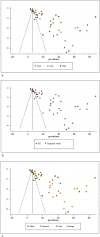Bacterial coinfection and antibiotic resistance in hospitalized COVID-19 patients: a systematic review and meta-analysis
- PMID: 37128208
- PMCID: PMC10148641
- DOI: 10.7717/peerj.15265
Bacterial coinfection and antibiotic resistance in hospitalized COVID-19 patients: a systematic review and meta-analysis
Abstract
Background: There were a few studies on bacterial coinfection in hospitalized COVID-19 patients worldwide. This systematic review aimed to provide the pooled prevalence of bacterial coinfection from published studies from 2020 to 2022.
Methods: Three databases were used to search the studies, and 49 studies from 2,451 identified studies involving 212,605 COVID-19 patients were included in this review.
Results: The random-effects inverse-variance model determined that the pooled prevalence of bacterial coinfection in hospitalized COVID-19 patients was 26.84% (95% CI [23.85-29.83]). The pooled prevalence of isolated bacteria for Acinetobacter baumannii was 23.25% (95% CI [19.27-27.24]), Escherichia coli was 10.51% (95% CI [8.90-12.12]), Klebsiella pneumoniae was 15.24% (95% CI [7.84-22.64]), Pseudomonas aeruginosa was 11.09% (95% CI [8.92-13.27]) and Staphylococcus aureus (11.59% (95% CI [9.71-13.46])). Meanwhile, the pooled prevalence of antibiotic-resistant bacteria for extended-spectrum beta-lactamases producing Enterobacteriaceae was 15.24% (95% CI [7.84-22.64]) followed by carbapenem-resistant Acinetobacter baumannii (14.55% (95% CI [9.59-19.52%])), carbapenem-resistant Pseudomonas aeruginosa (6.95% (95% CI [2.61-11.29])), methicillin-resistant Staphylococcus aureus (5.05% (95% CI [3.49-6.60])), carbapenem-resistant Enterobacteriaceae (4.95% (95% CI [3.10-6.79])), and vancomycin-resistant Enterococcus (1.26% (95% CI [0.46-2.05])).
Conclusion: All the prevalences were considered as low. However, effective management and prevention of the infection should be considered since these coinfections have a bad impact on the morbidity and mortality of patients.
Keywords: Antibiotic-resistant bacteria; Bacterial coinfection; COVID-19; Prevalence; Systematic review.
© 2023 Che Yusof et al.
Conflict of interest statement
Mohd Noor Norhayati is an Academic Editor for PeerJ.
Figures



References
-
- Abdollahi A, Aliramezani A, Salehi M, Shadehi MN, Ghourchian S, Douraghi M. Co-infection of ST2(IP) carbapenem-resistant Acinetobacter baumannii with SARS-CoV-2 in the patients admitted to a Tehran tertiary referral hospital. BMC Infectious Diseases. 2021;21(1):927. doi: 10.1186/s12879-021-06642-2. - DOI - PMC - PubMed
-
- Ahmed N, Khan M, Saleem W, Karobari MI, Mohamed RN, Heboyan A, Rabaan AA, Mutair AA, Alhumaid S, Alsadiq SA, Bueid AS, Santali EY, Alestad JH. Evaluation of bi-lateral co-infections and antibiotic resistance rates among COVID-19 patients. Antibiotics. 2022;11(2):276. doi: 10.3390/antibiotics11020276. - DOI - PMC - PubMed
-
- Alqahtani A, Alamer E, Mir M, Alasmari A, Alshahrani MM, Asiri M, Ahmad I, Alhazmi A, Algaissi A. Bacterial coinfections increase mortality of severely III COVID-19 patients in Saudi Arabia. International Journal of Environmental Research and Public Health. 2022;19(4):2424. doi: 10.3390/ijerph19042424. - DOI - PMC - PubMed
Publication types
MeSH terms
Substances
LinkOut - more resources
Full Text Sources
Medical
Research Materials

